![]()
![]()
![]()
Use LEFT and RIGHT arrow keys to navigate between flashcards;
Use UP and DOWN arrow keys to flip the card;
H to show hint;
A reads text to speech;
47 Cards in this Set
- Front
- Back
|
hormones
|
distributed by blood; sent thru capillaries to target cells with receptor molecules. may stimulate different responses in different cells. secreted by endocrine cells.
|
|
|
paracrines
|
influence nearby cells with chemical signals
|
|
|
autocrines
|
influence same cell with chemical signals
|
|
|
growth factors
|
stimulate growth/differentiation of cells. a major class of paracrine hormones. can also act as autocrine hormones (negative feedback)
|
|
|
endocrine gland
|
An aggregation of secretory cells that secretes hormones into the blood. The endocrine system consists of all endocrine cells and endocrine glands in the body that produce and release hormones. single gland may secrete multiple hormones
|
|
|
exocrine gland
|
Any gland, such as a salivary gland, that secretes to the outside of the body or into the gut.
|
|
|
peptide/protein hormones
|
these hormones (insulin is an example) are water-soluble and thus are easily transported in the blood without carrier molecules. Peptide and protein hormones are packaged in vesicles within the cells that make them; they are released by exocytosis. Their receptors are on cell surfaces.
|
|
|
steroid hormones
|
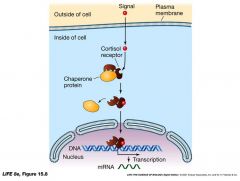
(such as testosterone) are synthesized from the steroid cholesterol, are lipid-soluble, and easily pass through cell membranes. Steroid hormones diffuse out of the cells that make them and are usually bound to carrier molecules in the blood. Their receptors are mostly intracellular in the cytoplasm or nucleus . They act by altering gene expression in the target cell (so usually slower but longer-lasting effects)
|
|
|
amine hormones
|
mostly synthesized from the amino acid tyrosine (thyroxine or epinephrine is an example). Some amine hormones are water-soluble and others are lipid-soluble; their modes of release differ accordingly.
|
|

Pituitary gland: the go-between for Nervous system and endocrine system
anterior vs posterior pituitary |
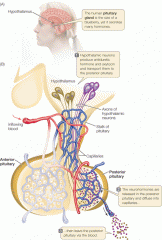
In contrast to the posterior pituitary, the anterior pituitary makes and secretes its own hormones
ANTERIOR: made from gut epithelial cells. contains endocrine cells controlled by neurohormones secreted by the hypothalamus. produces 4 protein and peptide hormones, which control other endocrine glands (tropic hormones). [LH, FSH, corticotropin (stim. cortisol) thyrotropin (stim. thyroxine)]. also produces prolactin, endorphins/enkephalins, melanocyte, and GH. Corticotropin, melanocyte-stimulating hormone, endorphins, and enkephalins all result from the cleavage of POMC. POSTERIOR: made from neural tissue. contains axons from hypothalamic neurons. antidiuretic hormone and oxytocin received from the hypothalamus, and then released. Posterior secretes neurohormones b/c axons extend from hypothalamus to posterior pituitary. |
|
|
antidiuretic hormone (ADH)
|
increase water absorption in kidneys. When ADH secretion is high, the kidneys produce only a small volume of highly concentrated urine. When ADH secretion is low, the kidneys produce a large volume of dilute urine. POSTERIOR increases ADH when b.p. falls or is too salty. AKA Vasopressin b/c at high concentrations it causes the constriction of peripheral blood vessels as a means of elevating blood pressure.
|
|
|
oxytocin
|
released by POSTERIOR. stimulates the uterine contractions that deliver the baby and stimulated milk flow. promotes social bonding.
|
|
|
Growth Hormone
|
produced by ANTERIOR. stimulates cells to take up amino acids, and stimulates endocrine cells in the liver to produce chemical signals called insulin-like growth factors, which stim. bone and cartilage growth. overproduction=gigantism; underproduction=pituitary dwarfism.
|
|
|
corticotropin
|
tropic hormone produced by ANTERIOR. stimulates release of cortisol in adrenal gland. cortisol reaches anterior pituitary via blood, inhibits further release of corticotropin.
Cortisol-- also a negative feedback signal to hypothalamus; inhibits corticotropin-releasing hormone. *in some cases, the tropic hormone can also act as a negative feedback signal for the neurohormone |
|
|
thyroid gland
|
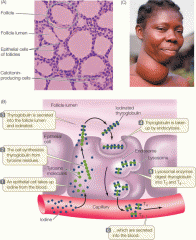
made up of 2 cell types:
epithelial cells, which make up follicles, and produce thyroxine calcitonin-producing cells, in spaces between follicles epithelial cells synthesize thyroglobulin (from tyrosine molecules), which is secreted into the lumen (center) of the follicle) where it is ionized (iodine from blood) and stored until the epithelial cells process it. lysosomal enzymes in epithelial cells digest thyroglobulin to create T3 and T4 (thyroxine). T4 is produced more, but T3 is more active. T4 can be made into T3 by enzymes in target cell. |
|
|
hypothyroid goiter
|
not enough thyroxine in blood to create negative feedback loop. Iodine deficiency can result in hypothyroid goiter. In this condition, a lack of functional thyroxine results in oversynthesis of thyroglobulin and subsequent enlarged follicles.
|
|
|
hyperthyroid goiter
|
usually caused by autoimmune deficiency, where an antibody binds to TSH receptors on follicles, causing uncontrolled release of thyroxine.
even though TSH levels in blood get really low (because of negative feedback still occurring) the thyroid still gets bigger from high Thyroxine levels. leads to high metabolic rates. |
|
|
thyroxine
|
regulates cell metabolism. lipid-soluble, binds to nucleus receptors in most cells. this combo acts as a transcription factor, which stimulates the transcription of genes that produce enzymes. these enzymes are involved in metabolic pathways, structural proteins and transport proteins.
elevates metabolic rates in most cells. cold lasting a couple days=increased thyroxine release, increase of T4 conversion to T3, increased basal metabolic rate. crucial during growth. promotes amino acid uptake and protein synthesis. raises blood (glucose) and promotes carb use of over fats. promotes amino acid uptake/protein synthesis. |
|
|
hormones which regulate blood calcium concentration
|
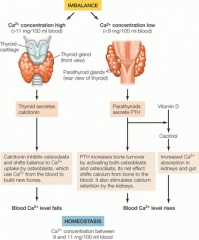
calcitonin, parathyroid hormone, Vitamin D hormone.
|
|
|
calcitonin
|
released by the thyroid. lowers blood calcium concentration mainly by bone absorption--decreases osteoclast activitiy. more important in young people whose bones are still growing.
|
|
|
osteoclasts
|
break down bone and release calcium into the blood.
|
|
|
osteoblasts
|
take up calcium from blood to deposit into new bone.
|
|
|
parathyroid hormone (PTH)
|
most important hormone in regulation of blood calcium levels. increases calcium in blood by stimulating bone turnover and stimulating re-absorption in kidneys. Also activates synthesis of calcitriol from Vit. D which causes absorption in the gut.
calcium in blood activates receptors in plasma membrane of parathyroid cells, which inhibit PTH. |
|
|
Vitamin D
|
synthesized by body, so not actually a vitamin. synthesizes calcitriol, which causes absorption of Ca+ in the digestive tract.
|
|
|
diabetes mellitus
|
caused by lack of insulin (Type I) or lack of insulin responsiveness in target tissues (Type II).
glucose transporters facilitate movement across membranes. they are controlled by insulin, which binds to cell receptors and causes them to move. glucose accumulates in the blood without insulin to help the transporters move it. urine production goes up because of the high amount of glucose that causes more water to be diffused by osmosis into blood and kidneys. muscle cells must depend on fat and protein for fuel, and fat (adipose) tissue cant replenish triglycerides, making the body waste away. diabetics lack metabolic fuel and are dehydrated. |
|
|
islets of langerhans
|
clusters of endocrine cells in the pancreas. the three types of cells in the clusters are alpha (produce/secrete glucagon, which stim. liver to break down glycogen, release glucose) beta (produce/secrete insulin, which stim. storage of glucose as glycogen), and delta cells (produce somatostatin)
|
|
|
glucose
|
after a meal, glucose is absorbed into gut from food, and the glucose level in blood increases, which stim. beta cells to release insulin. insulin causes target cells to start using glucose as a fuel instead of fat and glycogen, and also to convert it into these two. when glucose levels fall in blood, target cells go back to using glycogen and fat as fuel.
if glucose levels fall too low, alpha cells release glucagon. |
|
|
somatostatin
|
hormone released in delta cells in pancreas, in response to rapid increase of glucose and amino acids in blood.
Has paracrine functions within islets. inhibits release of insulin and glucagon. outside the pancreas, it slows the digestive activities of gut, extending absorption. also produced in the hypothalamus and sent to the anterior pituitary as a neurohormone, where it inhibits thyrotropin and GH. |
|
|
adrenal glands
|
core-adrenal medulla; produces epi and norepi. under control of nervous system b/c developed from neural tissue.
epinephrine increases heart rate and blood pressure and diverts blood flow to active muscles and away from the gut and skin. Norepinephrine has similar functions. outer tissue-adrenal cortex; produces steroids. under hormonal control (corticotropin) |
|
|
epinephrine and norepinephrine
|
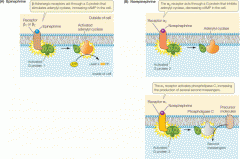
bind to alpha receptors and beta receptors. norepinephrine preferred by alpha receptors.
alpha receptors most common on cells in sympathetic nervous system. One class of the β-adrenergic receptors are found on cells not innervated by the sympathetic fibers, so they are positioned to respond to circulating epinephrine. Epinephrine acts on many different target cells in the body: - In the heart, it stimulates faster (increases HR) and stronger (increases stroke volume) heartbeat (increase cardiac output) CO = HR x SV Blood vessels in some areas (gut, skin, etc.) constrict to send more blood to skeletal muscles. In the liver, glycogen is broken down to glucose to provide quick energy. In fat tissue, fats are mobilized as another energy source. epinephrine activates adenyl cyclase, creates cAMP and uses it norepinephrine inhibits adenyl cyclase, doesnt create cAMP, creates secondary messengers |
|
|
beta blockers
|
block beta receptors, reduce the fight-or-flight response to epinephrine without affecting norepinephrine. commonly prescribed to reduce anxiety.
|
|
|
adrenal cortex
|
uses cholesterol to produce three steroid hormones, called corticosteroids. includes glucocorticoids, mineralocorticoids, and sex steroids(mainly produced in gonads).
glucocorticoids influence blood glucose conc. and fat, protein and carb metabolism. mineralocorticoids influence salt & water balance in extracellular fluid. sex steroids influence development, behavior, anabolism. |
|
|
Aldosterone
|
a major minteralocorticoid, stim. kidneys to excrete potassium and conserve sodium.
|
|
|
cortisol
|
main glucocorticoid, critical for mediating the body’s metabolic responses to stress.
cortisol rises during stress. shifts blood glucose use away from not critical cells (they use fats and proteins for energy). controlled by corticotropin. much slower response to stress than epinephrine (sometimes is a transcription factor) |
|
|
androgens
|
male sex steroids; dominant one is testosterone.
sex steroids increase during puberty. production controlled by tropic hormones Luteinizing Hormone, and Follicle stimulating hormone (gonadotropins). production of these tropic hormones by the anterior pituitary is under the control of the hypothalamic neurohormone gonadotropin-releasing hormone (GnRH). Puberty--initiated by reduced sensitivity of GnRH-producing cells to neg. feedback from sex steroids/gonadotropins. |
|
|
pineal gland
|
produces melatonin.
melatonin only is released in the dark to make the length of night. light inhibits melatonin. |
|
|
photoperiodicity
|
seasonal changes in length of day cause behavioral and physiologic changes. humans not strongly photoperiodic.
|
|
|
adrenal medulla
|
produces norepi and epi. which stim. flight or fight response:raises blood sugar, more blood to muscles, increased heart rate.
|
|
|
adrenal cortex
|
produces glucocorticoid (cortisol) which stim. stress response.
produces mineralocorticoids (aldosterone, activated by angiotensin II--[kidney changes renin->angiotensin I, ACE changes->angiotensin II), which stim. excretion of postassium and absorption of sodium ions. |
|
|
secretin
|
peptide hormone produced in small intestine lining (duodenum), targets pancreas. stim. release of alkaline solutions from the pancreas to small intestine. stim. secretion of bicarbonate solution by pancreas ducts.
|
|
|
gastrin
|
secreted from stomach lining, peptide hormone that targets stomach, promotes digestion of food by release of digestive juices. stim. stomach movements that mix food/juices
|
|
|
melatonin
|
secreted by pineal gland, targets hypothalamus, involved in circadian rhythms, measures length of day, seasonal changes.
|
|
|
ovarian cycle
|
at beginning, there is primary oocyte. after one week, only one survives/develops. nourished by follicalur cells, which also produce estrogen. meiotic division before ovulation creates second oocyte (2n). at ovulation, follicle ruptures, releasing egg. remaining follicle cells form corpus luteum (produces progesterone, estrogen)
uterine and ovarian cycles are parallel. menstruation marks beginning. few days before, pituitary increases FSH and LH. this surge of FSH and LH causes ovulation. this occurs days 12-14, occurs due to positive feedvack (estrogen causes extra FSH/LH to release egg). estrogen exerts negative feedback to pituitary all other times. once egg released, corpus luteum functions as endocrine gland, makes estrogen and progesterone. sex steroids exert neg. feedback on pituitary, inhibit GnRH and new follicle growth. but without fertilization, corpus lueteum dies, steroids die, all other hormones increase to restart cycle. |
|
|
Gonadotropin-releasing hormone (GnRH)
|
causes the anterior pituitary to release tropic hormones that control gonad activity (FSH & LH)
|
|
|
renin
|
Recall that the kidneys release renin (a proteolitic enzyme) into the blood. Renin cleaves a peptide angiotensin-I from circulating angiotensinogen. Angiotensin converting enzyme (ACE) (released into the blood by endothelial cells) converts angio-I to angiotensin-II.
Renin release is stimulated by lo blood Na+ and /or lo blood pressure |
|
|
Peptide YY
|
inhibits appetite (sim. to leptin)
|
|
|
ghrelin
|
stimulates appetite, produced in stomach/pancreas
released by hypothalamus to stimulate GH |

